As a parent, witnessing your child in discomfort can be distressing, especially when the problem is as common yet misunderstood as constipation. Understanding the nuances of this condition, recognizing its signs, and knowing how to effectively manage it can significantly improve your child’s wellbeing. This guide aims to arm parents with essential knowledge about constipation in children, offering insights into causes, symptoms, treatments, and prevention strategies.
Table of Contents
Understanding Constipation in Children
Constipation is a prevalent issue among children, characterized by infrequent bowel movements or difficulty passing stools. It’s not just about frequency; the consistency and effort required can also indicate a problem. Understanding its commonality is the first step towards addressing it effectively.
Causes of Constipation in Children
- Dietary Factors: One of the most common causes of constipation in children is a diet low in fiber. Fiber helps to bulk up stools and promotes regular bowel movements. Children who consume a lot of processed foods, cheese, meat, and sugary snacks, but not enough fruits, vegetables, whole grains, and legumes, are more likely to experience constipation.
- Insufficient Fluid Intake: Adequate hydration is essential for preventing constipation. Water and other fluids help to soften the stool, making it easier to pass. Children who do not drink enough fluids during the day may become dehydrated, leading to harder stools and constipation.
- Lack of Physical Activity: Regular physical activity helps stimulate the intestines and promote bowel movements. A sedentary lifestyle, with too much time spent sitting or engaging in low-activity pursuits like watching TV or playing video games, can increase the risk of constipation in children.
- Toilet Training Issues: Toilet training can be a stressful time for children and parents alike. Children who are pressured to toilet train before they are ready, or who have had negative experiences with toilet training, may withhold stool, leading to constipation. Fear of using public bathrooms can also contribute to this issue.
- Changes in Routine: Children thrive on routine, and any significant changes, such as starting school, traveling, or experiencing family stress, can affect their bowel movements. During times of change or stress, children may ignore the urge to use the bathroom, leading to constipation.
- Medications: Certain medications, including some antidepressants, anticonvulsants, and opiate pain relievers, can cause constipation as a side effect. Always consult with a healthcare provider about the potential side effects of any medication your child is taking.
- Medical Conditions: Though less common, certain medical conditions can cause constipation in children. These include neurological disorders, such as cerebral palsy; endocrine disorders, like hypothyroidism; and anatomical anomalies of the digestive system.
- Milk Intolerance: Some children may experience constipation due to an intolerance to cow’s milk. This intolerance can lead to digestive issues, including constipation, in susceptible children.
- Holding Back Stools: Children may sometimes deliberately withhold bowel movements due to various reasons, such as fear of pain from passing hard stools, reluctance to interrupt play, or anxiety about using unfamiliar toilets. This can lead to a cycle of constipation and discomfort.
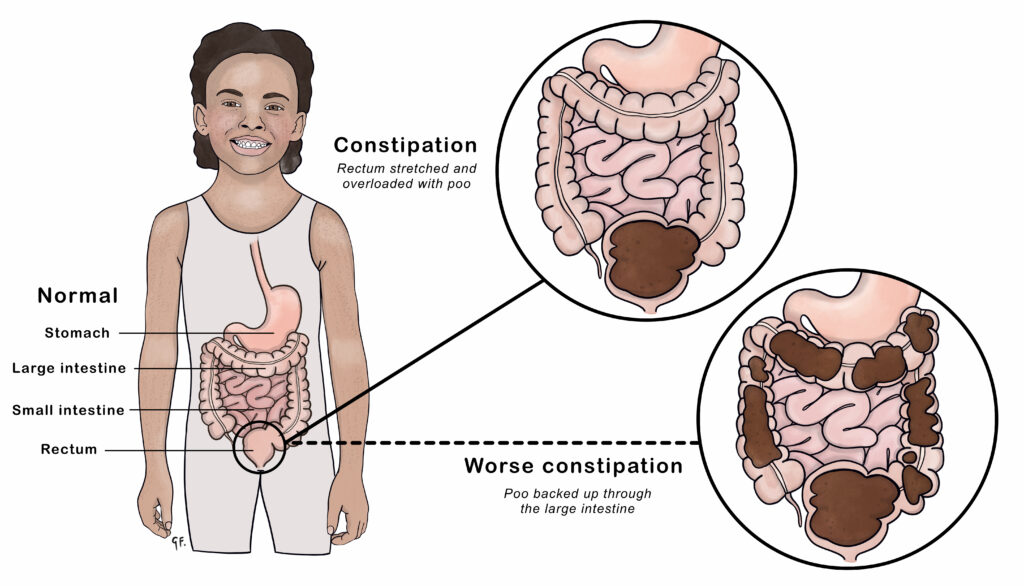
Recognizing the Signs of Constipation in Children
- Infrequent Bowel Movements: One of the most obvious signs of constipation is fewer bowel movements than normal. While frequency varies with age and diet, going three or more days without a bowel movement can indicate constipation, especially if this is a noticeable change for the child.
- Hard, Dry, or Large Stools: If the child’s stools are consistently hard, dry, or larger than usual, this can signal constipation. These types of stools can be difficult and sometimes painful to pass, leading to avoidance of bowel movements.
- Pain or Discomfort During Bowel Movements: Children experiencing constipation may express discomfort, pain, or even cry when trying to pass stools. This discomfort can lead to fear of going to the bathroom, further exacerbating the problem.
- Visible Straining: If a child is straining or spending a long time on the toilet attempting to pass stool, this can be a clear sign of constipation. Straining is often accompanied by a red face and can indicate that the child is having difficulty with bowel movements.
- Blood on the Surface of Stool or Toilet Paper: The strain of passing hard, dry stools can cause tiny tears in the skin around the anus (anal fissures), leading to bleeding. Noticing a small amount of bright red blood on the stool or toilet paper after wiping is a sign that the constipation may be causing discomfort.
- Stomach Ache and Cramps: Constipation can cause stomach discomfort, including dull aches and cramps. These pains are often relieved by a bowel movement.
- Bloating and a Feeling of Fullness: A child may complain of feeling bloated or having a full belly. In some cases, you may even notice that the child’s belly appears distended.
- Nausea and Loss of Appetite: With constipation, the buildup of stool in the intestine can cause a feeling of nausea or a decrease in appetite, as the child feels too full to eat.
- Soiling Accidents: In some instances, constipation can lead to a condition called encopresis, where liquid stool leaks around the hard stool, leading to unexpected soiling of underwear. This is often mistaken for diarrhea or a lack of toilet training.
- Behavioral Changes: A child who is constipated may become irritable, less active, or show changes in behavior due to discomfort and feeling unwell.
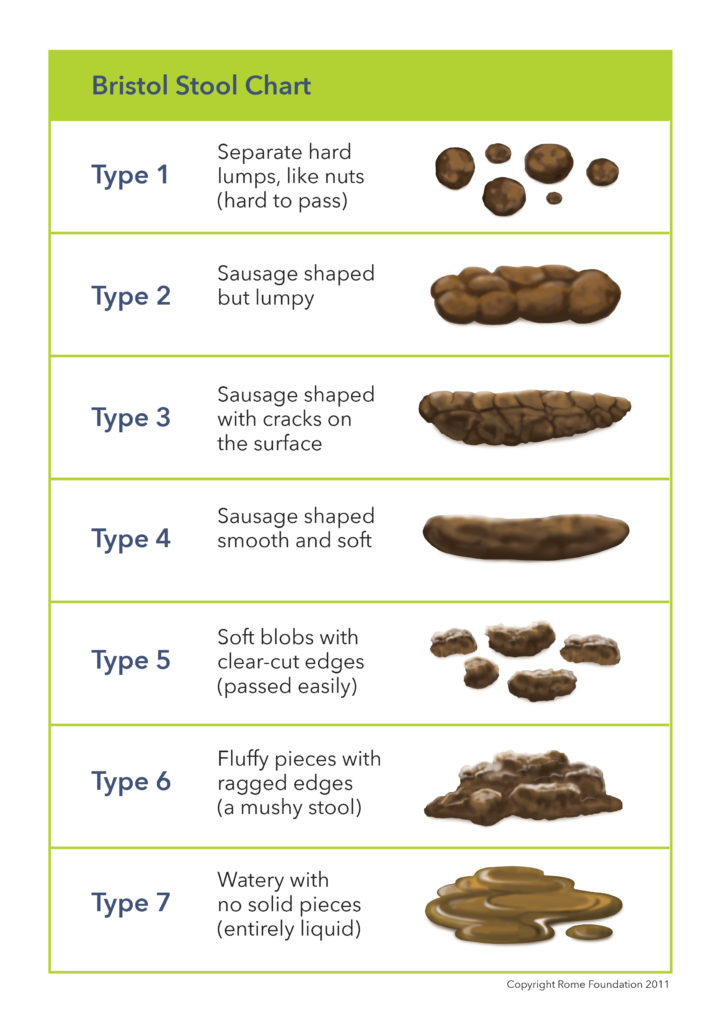
Encouraging Physical Activity
- Lead by Example: Children often mimic the behaviors of adults around them. By leading an active lifestyle yourself, you’re showing your child the importance of physical activity. Engage in regular exercise and invite your child to join you in activities such as walking, biking, or playing sports together.
- Make Physical Activity Fun: For children, play is the most natural form of physical activity. Encourage play that gets them moving, such as tag, jump rope, hide-and-seek, or sports like soccer and basketball. The more enjoyable the activity, the more likely they will want to participate.
- Limit Screen Time: With the rise of digital devices, children are spending more time sitting and less time moving. Setting limits on screen time can help encourage children to find alternative forms of entertainment that require physical movement.
- Incorporate Activity into Daily Routines: Walking or biking to school, taking the stairs instead of the elevator, and having active chores at home can integrate physical activity into daily life. These small changes can make a big difference in overall activity levels.
- Enroll Them in Organized Activities: Many communities offer sports leagues, dance classes, martial arts, and other organized activities that cater to children. These can be excellent ways for kids to stay active, learn new skills, and socialize.
- Create Challenges or Goals: Setting up challenges or goals can motivate children to be more active. This could be a step count challenge, learning a new skill in a sport, or achieving a new level in a physical activity they enjoy.
- Provide the Necessary Equipment: Having access to the right equipment can make physical activity more appealing. This doesn’t have to be expensive or elaborate; even a ball, jump rope, or bike can provide endless opportunities for movement.
- Use Technology Positively: While limiting screen time is important, technology can also be used to encourage activity. Apps and video games that require physical movement can be a fun way to get kids moving indoors.
- Encourage Social Activity: Children are more likely to engage in physical activity if it involves social interaction. Playdates, team sports, and family outings that include physical activities can make exercise more appealing.
- Praise and Encourage Effort: Positive reinforcement can go a long way in motivating children. Praise their efforts, participation, and improvements rather than focusing solely on achievement or skill level.
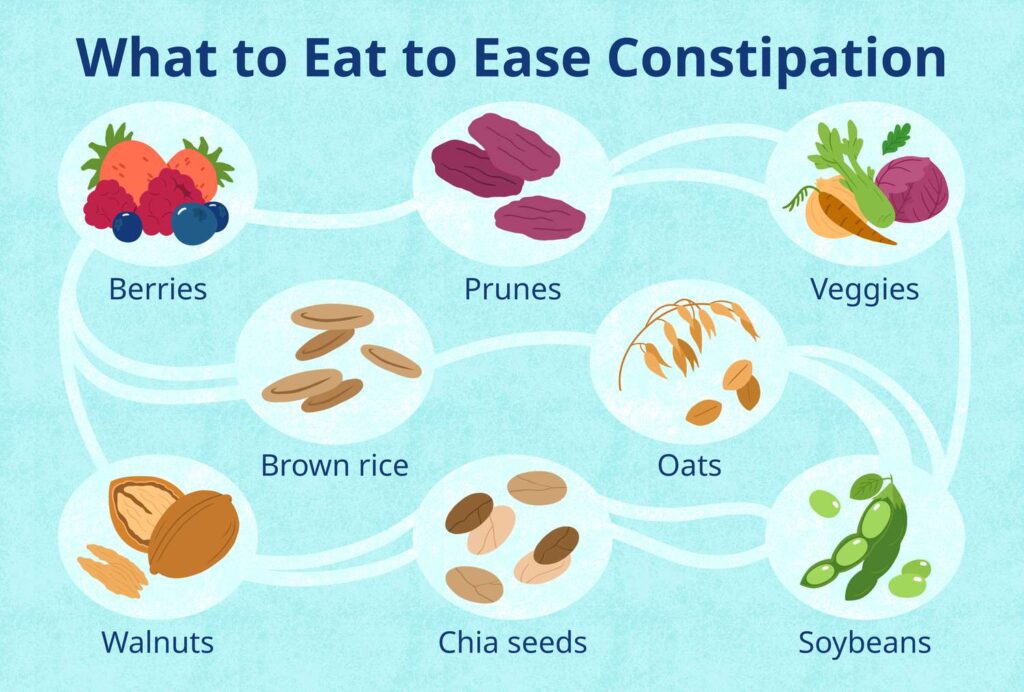
Over-the-counter Solutions
- Fiber Supplements: Fiber supplements, such as psyllium (Metamucil) or methylcellulose (Citrucel), can help increase the fiber content in your child’s diet, aiding in stool bulk and regularity. These should be used under a healthcare provider’s guidance, especially for young children.
- Stool Softeners: Stool softeners, like docusate sodium (Colace), work by drawing water into the stool, making it softer and easier to pass. They are generally considered safe for children but should be used as directed by a physician.
- Lubricant Laxatives: Mineral oil is a type of lubricant laxative that coats the stool and the bowel’s lining, making it easier for stool to slide through the intestine. It’s not typically recommended for long-term use or for young children due to the risk of aspiration (inhaling the oil into the lungs).
- Osmotic Laxatives: Osmotic laxatives, such as polyethylene glycol 3350 (MiraLAX), work by drawing water into the colon, which helps soften the stool and stimulate bowel movements. MiraLAX is commonly recommended for children with constipation, but it’s important to use it under medical supervision.
- Stimulant Laxatives: Stimulant laxatives, including bisacodyl (Dulcolax) and senna (Senokot), trigger the intestines to contract, pushing the stool out. These are generally used as a last resort for children due to the potential for discomfort and cramping.
Important Considerations:
- Consult a Healthcare Provider: Before starting any OTC solution, especially for a child, it’s important to consult with a healthcare provider to ensure it’s appropriate and safe for your child’s specific situation.
- Follow Dosage Instructions: Carefully follow the dosage instructions on the package or those given by your child’s healthcare provider. Overuse or incorrect use of laxatives can lead to problems such as dependency or worsened constipation.
- Monitor for Side Effects: Keep an eye out for any side effects, such as abdominal pain, nausea, or diarrhea, and report these to your healthcare provider.
- Use as Part of a Broader Approach: OTC solutions should be used as part of a broader approach to managing constipation that includes dietary changes, increased fluid intake, and physical activity.
- Prevention is Key: Ultimately, the goal is to prevent constipation through a healthy diet rich in fiber, adequate hydration, and regular physical activity. OTC solutions can help in the short term but addressing the underlying lifestyle factors is crucial for long-term management.
When to Seek Professional Help
- Persistent Constipation: If your child’s constipation persists for several weeks, despite dietary changes, increased physical activity, and adequate hydration, it’s time to consult a doctor. Persistent constipation can indicate underlying health issues that need professional assessment.
- Blood in Stool: The appearance of blood in your child’s stool or on the toilet paper after wiping is a sign that should never be ignored. While it can be a result of straining, it’s essential to rule out more serious conditions.
- Severe Pain or Discomfort: If your child experiences significant pain or discomfort during bowel movements or complains of ongoing abdominal pain, these symptoms warrant a professional evaluation to determine the underlying cause and appropriate treatment.
- Changes in Bowel Movement Patterns: Sudden and unexplained changes in the frequency, consistency, or ease of bowel movements can be a sign of underlying health issues.
- Accompanying Symptoms: Symptoms such as unexplained weight loss, fever, vomiting, or a noticeable decrease in appetite alongside constipation are red flags that should prompt immediate medical attention.
- Anal Fissures: If you notice fissures (small tears around the anus) or if your child complains of anal pain, a healthcare provider can offer treatments to ease discomfort and promote healing.
- Failure to Respond to Over-the-Counter Treatments: If over-the-counter remedies have not improved the situation, or if you’re unsure about the appropriate treatment, seek professional advice before proceeding.
- Soiling or Encopresis: Involuntary soiling in a previously toilet-trained child can indicate chronic constipation and requires professional intervention to address both the physical and emotional aspects of the condition.
- Signs of a More Serious Condition: In rare cases, constipation can be a symptom of a more serious underlying condition, such as a thyroid disorder, celiac disease, or Hirschsprung’s disease. A healthcare provider can conduct necessary tests to diagnose these conditions.
- If You’re Worried: Ultimately, you know your child best. If you’re concerned about your child’s health for any reason, it’s always better to err on the side of caution and consult a healthcare professional.
Conclusion
Constipation in children is a common yet manageable condition. By understanding its causes, recognizing its signs, and applying effective treatment and prevention strategies, parents can help their children achieve and maintain digestive health. Remember, when in doubt, seeking professional advice is always the best course of action.
FAQs
- How often should a child have a bowel movement?
- The frequency can vary widely among children, but going less than three times a week may indicate constipation.
- Can stress cause constipation in children?
- Yes, emotional stress can impact bowel movements, leading to constipation.
- Are there any specific fruits known to help with constipation?
- Fruits high in fiber such as prunes, pears, and apples can be particularly helpful.
- How can I make it easier for my child to talk about bowel movements?
- Normalize the conversation around bowel health from an early age and encourage open, shame-free discussions.
- When should I be concerned about my child’s constipation?
- If constipation is accompanied by severe pain, blood in the stool, or if it persists despite home treatment, consult a healthcare professional.
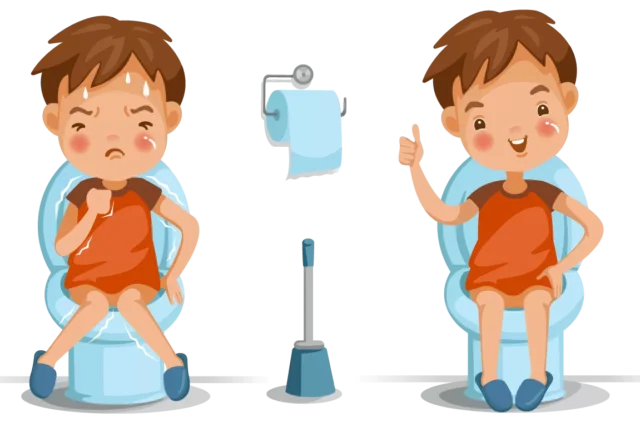
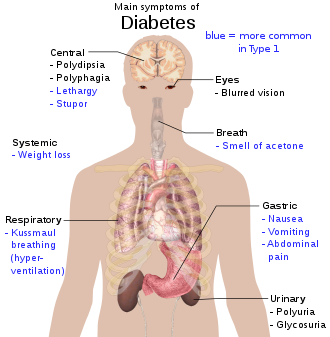
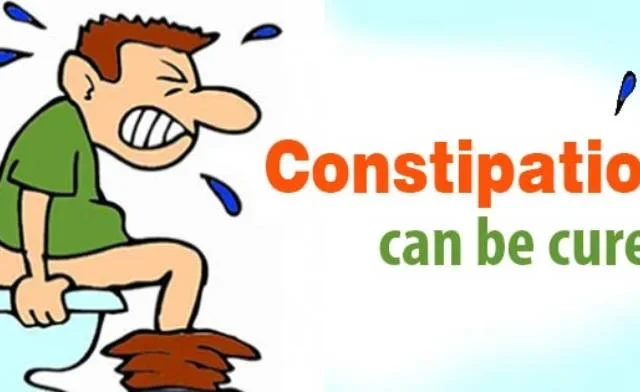
MOST COMMENTED
Animal-Based Proteins / Casein Protein / Dietary Protein / High-Protein Diets / Pea Protein / Plant-Based Proteins / Protein / Protein Deficiency / Protein Supplements / Proteins / Whey Protein / Whey Proteins
Is Protein Powder Safe for Teenagers and Children?
Animal-Based Proteins / Casein Protein / Dietary Protein / High-Protein Diets / Pea Protein / Plant-Based Proteins / Protein / Protein Deficiency / Protein Supplements / Proteins / Whey Protein / Whey Proteins
Unlock the Power of Proteins for Optimal Gut Health
Animal-Based Proteins / Casein Protein / Dietary Protein / High-Protein Diets / Pea Protein / Plant-Based Proteins / Protein / Protein Deficiency / Protein Supplements / Proteins / Whey Protein / Whey Proteins
Pea Proteins: The Best Plant-Based Protein Alternative?
Multivitamin
Total Health: Multivitamin for Active Lifestyles
Multivitamin
WellnessFusion: Complete Multivitamin Support
Dietary Supplement
Revitalize Your Health: The Magic of Red Yeast Rice Capsules
Foot care / Foot Health
Revitalize Your Foot Care Routine: Essential Tips for Optimal Foot Health
Foot Problem / Diabetics / Foot Health
Diabetics: Mastering Footwear Selection for Enhanced Foot Health and Ultimate Comfort
Exercises and Footwear Tips for Hammertoe Relief / Foot care / Foot Health / Foot Pain / Foot Problem / Hammertoes
Unlock Effective Exercises and Footwear Tips for Hammertoe Relief
Hammertoes / Foot Health / Foot Pain / Foot Problem
Unlock Relief: Essential Guide to Hammertoes Causes, Symptoms, and Treatments